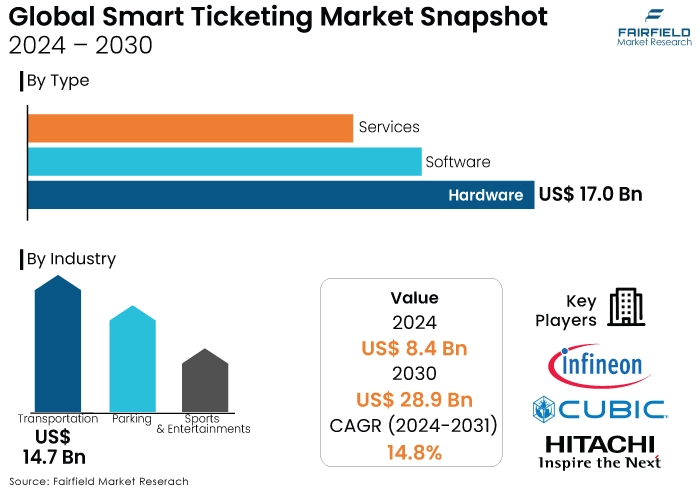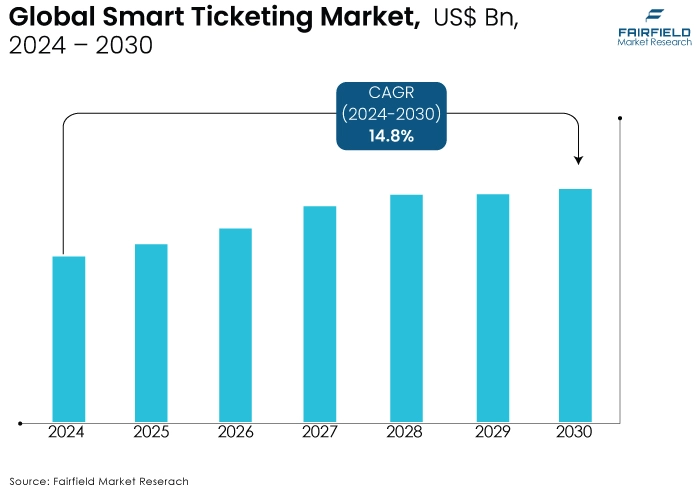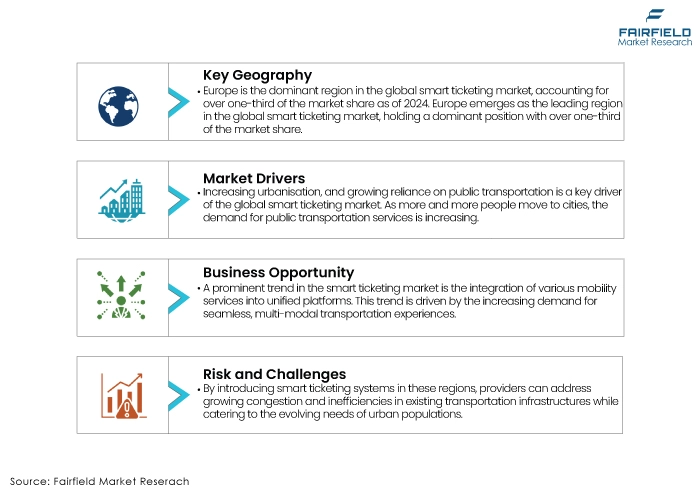Global Smart Ticketing Market Forecast
- Global smart ticketing market to be worth US$28.9 Bn by 2030, up from US$8.4 Bn attained in 2018
- Market revenue projected to register a CAGR of 14.8% during the forecast period 2024-2030

Quick Report Digest
- Widening application of smart ticketing systems in public transportation systems, including buses, trains, and metros, as well as for events like concerts, sports matches, and movies will drive market expansion through 2030.
- Increasing urbanisation, and reliance on public transportation are key drivers, as cities seek efficient solutions to manage growing commuter populations.
- Demand for contactless payments has surged, with solutions like contactless cards, and mobile wallets facilitating seamless transactions and improving operational efficiency.
- The pandemic initially disrupted the industry but also accelerated the adoption of smart ticketing, especially contactless payment systems, to mitigate virus transmission risks.
- Hardware remains dominant, with services growing rapidly, particularly in implementation and system integration.
- Software, including ticketing platforms and fare management systems, is also poised for significant growth.
- Transportation is the largest revenue segment, driven by increasing adoption of smart ticketing by public transportation authorities globally.
- Sports, entertainment, and parking segments are also growing steadily.
- Asia Pacific leads in growth, propelled by the rapid expansion of urban areas and demand for public transportation, particularly in China, and India.
- Europe, and North America are major markets, while Latin America, and the Middle East and Africa show promising growth potential.
- The market is highly competitive, with major players like Infineon, Cubic, and Hitachi dominating. Strategies such as partnerships, mergers, and innovations are employed to enhance product offerings, and maintain competitive edge.
A Look Back and a Look Forward - Comparative Analysis
The growth trajectory of the smart ticketing market exhibited distinct patterns between 2018-2023 and 2024-2030. In the earlier period, the market experienced steady expansion driven by increasing urbanisation, rising demand for public transportation, and the adoption of contactless payment technologies. However, the outbreak of the COVID-19 pandemic in 2020 posed significant challenges, leading to a temporary slowdown as public transport ridership plummeted and deployment of new systems faced disruptions.
The COVID-19 pandemic has had a significant impact on the smart ticketing industry. Public transport ridership decreased sharply during the pandemic, leading to a decline in revenue for smart ticketing operators. Additionally, the pandemic has disrupted supply chains and made it difficult to deploy new smart ticketing systems.
However, the pandemic has also accelerated the adoption of smart ticketing in some areas. For example, many public transport operators have introduced contactless payment systems to reduce the risk of virus transmission. Additionally, the pandemic has led to a growing interest in smart ticketing solutions that can help to manage passenger flows and reduce crowding.
It is important to note that the impact of the pandemic on the smart ticketing market varied by region and industry. In some areas where the pandemic was effectively controlled or where vaccination rates were high, there was a quicker recovery in the smart ticketing market. Additionally, the continued adoption of digital and contactless technologies suggests a positive long-term outlook for the smart ticketing industry.
Nevertheless, the pandemic accelerated the shift towards contactless solutions, particularly in ticketing, spurring innovation and adaptation within the industry. As the world gradually recovered and adapted to the new normal, the market regained momentum, with a resurgence in demand for smart ticketing systems driven by urbanisation, environmental concerns, and the continued digitisation of transportation services.
Consequently, the forecast for 2024-2030 anticipates a robust growth trajectory, with the market projected to nearly triple in value, driven by technological advancements, increasing adoption across diverse sectors, and expanding global urban populations.

Key Growth Determinants
Increasing Urbanisation, and Reliance on Public Transportation
Increasing urbanisation, and growing reliance on public transportation is a key driver of the global smart ticketing market. As more and more people move to cities, the demand for public transportation services is increasing. Smart ticketing systems offer a number of advantages over traditional paper-based ticketing systems, including:
Smart tickets can be purchased and used through a variety of channels, including online, at vending machines, and on mobile devices. This makes it easier for passengers to purchase tickets and access public transportation services. Smart ticketing systems helps in reducing congestion and queues at ticket booths and fare gates. This leads to faster travel times and a more efficient public transportation system.
Smart tickets are more difficult to counterfeit than paper tickets. This helps in reducing ticket fraud and save transportation agencies money. Smart ticketing systems has the capability to collect data on ridership patterns and travel habits. This data can be used to improve public transportation services and make them more efficient.
With increasing concerns about traffic congestion, environmental sustainability, and the cost of private vehicle ownership, there is a growing dependence on public transportation systems globally. Governments and transportation authorities are investing in the development of robust public transport networks to encourage their use and reduce the number of private vehicles on the roads.
Rising Demand for Contactless Payments
The rising demand for contactless payments, the global smart ticketing market has witnessed a significant increase in the implementation of contactless ticketing solutions. These solutions enable users to purchase and validate tickets using contactless payment methods, such as contactless cards, mobile wallets, or wearable devices.
Implementing contactless ticketing systems not only provides a seamless, and convenient experience for customers but also improves operational efficiency for ticketing providers. It helps reduce queues, lower the costs associated with printing and distributing physical tickets, and enables real-time tracking and analysis of ticketing data.
According to Worldpay's Global Payments Report 2022, the global adoption rate of contactless payments reached 52% in 2021, up from 44% in 2020.
A number of cities around the world have already implemented smart ticketing systems that support contactless payments. For example, London, New York City, and Singapore all have smart ticketing systems that allow passengers to pay their fares with contactless cards or mobile devices.
In addition, contactless payments are highly secure. Contactless cards, and mobile devices use encryption technology to protect users' financial information. This makes contactless payments much safer than traditional payment methods, such as cash and credit cards.
Key Growth Barriers
Challenging Infrastructural Requisites
The implementation of smart ticketing systems often requires significant infrastructure investment, including the deployment of ticketing machines, card readers, and digital payment terminals.
In regions with outdated or insufficient infrastructure, such as rural areas or developing countries, the upfront costs, and logistical challenges of installing and maintaining these systems can be prohibitive.
Additionally, ensuring interoperability and seamless integration with existing transportation networks and payment systems may pose technical hurdles, further delaying adoption and expansion.
Concerns Hovering over Security and Privacy
Smart ticketing systems rely on digital technologies, which can be susceptible to security breaches and privacy infringements. Concerns about data security, identity theft, and unauthorised access to personal information may deter consumers from adopting smart ticketing solutions, particularly if they perceive the risks to outweigh the benefits.
Moreover, regulatory requirements surrounding data protection and privacy add complexity to compliance efforts for ticketing operators and service providers. Addressing these security and privacy concerns through robust encryption, authentication mechanisms, and transparent data handling practices is essential to building trust and fostering widespread acceptance of smart ticketing technologies.
Key Trends and Opportunities to Look at
Integration of Mobility Services
A prominent trend in the smart ticketing market is the integration of various mobility services into unified platforms. This trend is driven by the increasing demand for seamless, multi-modal transportation experiences. Consumers seek convenient solutions that allow them to plan, book, and pay for different modes of transport seamlessly, whether it's buses, trains, ride-sharing services, or bike-sharing programs.
Smart ticketing systems are evolving to accommodate this trend by integrating with mobility-as-a-service (MaaS) platforms, offering users a single point of access for all their transportation needs. This integration enhances user experience, promotes modal shift towards sustainable transportation options, and provides valuable data insights for service providers to optimise operations.
Expansion in Developing Economies
An opportunity lies in expanding smart ticketing solutions into emerging markets where urbanisation and public transportation demand are rapidly growing. Countries in Asia, Africa, and Latin America present vast untapped markets with increasing populations and burgeoning urban areas.
By introducing smart ticketing systems in these regions, providers can address growing congestion and inefficiencies in existing transportation infrastructures while catering to the evolving needs of urban populations. This expansion not only opens new revenue streams but also contributes to socio-economic development by improving accessibility and connectivity for underserved communities.
Enhanced Data Analytics and Personalisation
Another opportunity arises from leveraging advanced data analytics capabilities within smart ticketing systems to personalise services and improve user experiences. By harnessing data on travel patterns, preferences, and behaviors, operators can offer tailored recommendations, incentives, and pricing models to encourage sustainable travel choices and increase customer satisfaction.
Moreover, data-driven insights enable operators to optimise route planning, capacity management, and resource allocation, leading to greater operational efficiency, and cost savings. Embracing data-driven personalisation not only enhances the value proposition of smart ticketing solutions but also fosters stronger customer engagement, and loyalty in an increasingly competitive market landscape.

How Does Regulatory Scenario Shape this Industry?
The regulatory landscape plays a crucial role in shaping the growth of the smart ticketing market by establishing standards, frameworks, and guidelines that govern the implementation and operation of these systems. Regulations regarding data privacy, security, interoperability, and payment standards significantly influence the adoption and deployment of smart ticketing solutions. Compliance with regulatory requirements ensures consumer trust, promotes interoperability between different systems and operators, and fosters a level playing field for market participants.
Additionally, regulatory initiatives aimed at promoting innovation, such as open data policies and public-private partnerships, create opportunities for collaboration and investment in smart ticketing infrastructure. However, regulatory complexities and inconsistencies across regions can pose challenges for market players, requiring them to navigate diverse legal frameworks and ensure compliance with local regulations. A supportive and conducive regulatory environment is essential for driving the growth and sustainability of the smart ticketing market.
Fairfield’s Ranking Board
Top Segments
Hardware Remains the Dominant Segment by Component
By Component, the hardware segment is expected to account for the largest market share, followed by the services segment. This is due to the increasing adoption of smart ticketing solutions such as for smart card readers and ticket vending machines in various transportation modes, such as public transit, rail, and air.
The services segment is expected to grow at the fastest CAGR during the forecast period. In services segment, Implementation segment holds the major market share. System integration services help operators to deploy and integrate smart ticketing systems with their existing infrastructure. Maintenance and support services ensure that smart ticketing systems are kept up and running.
The software segment is expected to grow at a CAGR of 15.3% during the forecast period. The software segment includes ticketing platforms, fare management systems, and other software applications that support smart ticketing systems. Ticketing platforms allow operators to sell tickets online and through mobile apps. Fare management systems help operators track passenger movements and calculate fares.
Transportation Segment Takes up the Largest Revenue Share
The transportation segment accounted for the largest share of nearly 50% of the global smart ticketing market size in 2022. This is due to the increasing adoption of smart ticketing solutions by public transportation authorities around the world.
The sports and entertainment segment is also growing rapidly, as more and more sports venues and event organisers are adopting smart ticketing solutions. Smart ticketing systems can help to reduce queues, improve security, and personalise the fan experience.
The parking segment is also expected to grow in the coming years, as more and more cities and parking operators adopt smart ticketing systems. Smart ticketing systems can help to reduce congestion, improve traffic flow, and generate additional revenue for parking operators.
Regional Frontrunners
Europe’s Leadership Prevails, Market Share Surpasses 33%
Europe is the dominant region in the global smart ticketing market, accounting for over one-third of the market share as of 2024. Europe emerges as the leading region in the global smart ticketing market, holding a dominant position with over one-third of the market share.
The region boasts a well-established and extensive public transportation network, with many cities pioneering the adoption of smart ticketing solutions. Countries like the UK, Germany, France, and the Nordic nations have been at the forefront of implementing advanced ticketing technologies, including contactless payments, mobile ticketing, and integrated fare systems.
Furthermore, supportive regulatory frameworks, and government initiatives have encouraged widespread deployment and interoperability of smart ticketing systems across European cities. With strong emphasis on sustainability, efficiency, and seamless mobility, Europe continues to drive innovation and set benchmarks for smart ticketing initiatives globally.
North America is another major market for smart ticketing. The growing adoption of smart ticketing systems by public transportation operators in the region is driving the market growth. Latin America, and the Middle East and Africa are relatively smaller markets for smart ticketing. However, these markets are expected to grow at a significant CAGR in the coming years.

Exceptional Growth of Digital Economy Drives Asia Pacific at the Fastest Pace
With more than a fourth of the global market revenue, Asia Pacific is expected to be the fastest-growing market for smart ticketing in the coming years. This is due to the increasing urbanisation and growing demand for public transportation in the region. China, and India are the key markets for smart ticketing in the Asia Pacific region.
Asia Pacific gains from rapid urbanisation pace, population growth, and increasing reliance on public transportation in countries like China, India, Japan, and South Korea. Governments, and transportation authorities in the region are investing heavily in upgrading infrastructure and adopting smart technologies to address urban mobility challenges and enhance commuter experiences.
Moreover, the proliferation of smartphones, and digital payment platforms has accelerated the adoption of mobile ticketing and contactless payment solutions across Asia Pacific. With a burgeoning digital economy and a focus on smart city development, the region presents lucrative opportunities for smart ticketing providers to capitalise on the growing demand for efficient, convenient, and sustainable transportation solutions.
Fairfield’s Competitive Landscape Analysis
Leading players in the market are adopting strategies such as partnerships, mergers, collaborations, innovations, and acquisitions to enhance their product offerings and gain sustainable competitive advantage. The top 10 vendors recorded more than 60% market share in the year 2022 and will continue to hold a sizeable collective share through the end of forecast period.
Who are the Key Leaders in Smart Ticketing Space?
- Infineon
- Cubic
- Hitachi
- HID Global
- Siemens
- Conduent
- Scheidt & Bachmann GmbH
- Ticketer
- Atsuke
- Flowbird Group
- Cammax
Significant Industry Developments
- In 2023, nearly 1.4 crore local train passengers in Mumbai transitioned to smart ticketing options, marking a significant shift towards digital ticketing solutions. This migration from traditional paper tickets to smart ticketing platforms reflects a growing preference for convenient and efficient payment methods among commuters. The adoption of smart ticketing is expected to streamline ticketing processes, reduce queues, and enhance the overall commuter experience on Mumbai's local train network.
- In 2023, Delhi Metro conducted trials for a QR-based ticketing system and aims to launch it by June-end. The new system will enable passengers to purchase tickets via QR codes scanned through mobile apps, reducing the need for physical tickets. This move towards contactless, digital ticketing aligns with global trends, enhancing convenience and efficiency for commuters while also promoting safety measures in the wake of the COVID-19 pandemic.
- In 2023, UniCard, a subsidiary of the UK's Rail Delivery Group, has acquired the digital ticketing business of Ecebs from Visa. This acquisition strengthens UniCard's position in the smart ticketing market, enhancing its capabilities to provide innovative digital ticketing solutions for transportation services across the UK.
- In 2024, the UK's Rail Delivery Group (RDG) has successfully completed the UniCard process, a project aimed at simplifying ticketing for passengers across multiple train operators. UniCard enables passengers to travel seamlessly without needing separate tickets when transferring between different rail services. The completion of this process marks a significant milestone in improving the convenience and efficiency of rail travel for passengers in the UK.
An Expert’s Eye
The analyst's opinion on the growth outlook of the smart ticketing market emphasizes its promising trajectory, driven by evolving consumer preferences, technological advancements, and supportive regulatory frameworks. According to industry analysts, the market is poised for substantial expansion in the coming years, with projected revenues expected to nearly triple by 2030.
Factors such as increasing urbanization, rising demand for efficient transportation solutions, and the growing adoption of contactless payment methods are identified as key drivers propelling market growth. Additionally, advancements in data analytics, AI, and IoT technologies are anticipated to enhance the functionality and value proposition of smart ticketing systems, further fueling adoption across diverse sectors and geographic regions.
Despite challenges such as infrastructure constraints and security concerns, experts remain optimistic about the long-term prospects of the smart ticketing market, forecasting sustained growth and innovation in the years ahead.
Global Smart Ticketing Market is Segmented as Below:
By Type
- Hardware
- Software
- Services
- Consulting
- Implementation
- Support & Maintenance
By Industry
- Transportation
- Parking
- Sports & Entertainment
By Geographic Coverage:
- North America
- U.S.
- Canada
- Europe
- Germany
- U.K.
- France
- Italy
- Turkey
- Russia
- Rest of Europe
- Asia Pacific
- China
- Japan
- South Korea
- India
- Southeast Asia
- Rest of Asia Pacific
- Latin America
- Brazil
- Mexico
- Argentina
- Rest of Latin America
- Middle East & Africa
- GCC
- South Africa
- Egypt
- Nigeria
- Rest of Middle East & Africa
1. Executive Summary
1.1. Global Smart Ticketing Market Snapshot
1.2. Global Smart Ticketing Market Fairfield Analysis
2. Market Overview
2.1. Market Dynamics
2.1.1. Driver
2.1.2. Restraint
2.1.3. Opportunity
2.2. COVID-19 Impact
2.3. Eco-System Analysis
2.4. Smart Ticketing Vendor Landscape
2.5. Porters Five Forces
2.6. Smart Ticketing Timelines
2.7. Smart Ticketing End User Analysis
2.8. Market Trends
2.9. Smart Ticketing Development
3. Global Smart Ticketing Market Outlook, 2018-2030
3.1. Overview
3.2. Smart Ticketing Revenue (US$ Mn) by Component
3.2.1. Hardware
3.2.2. Software
3.2.3. Services
3.2.3.1. Consulting
3.2.3.2. Implementation
3.2.3.3. Support & Maintenance
3.3. Smart Ticketing Revenue (US$ Mn) by Application
3.3.1. Parking
3.3.2. Transportation
3.3.3. Sports & Entertainments Railway
3.4. Smart Ticketing Revenue (US$ Mn) by Region
3.4.1. North America
3.4.2. Europe
3.4.3. Asia Pacific
3.4.4. Latin America
3.4.5. Middle East & Africa
4. North America Smart Ticketing Market Outlook, 2018-2030
4.1. Overview
4.2. Smart Ticketing Revenue (US$ Mn) by Component
4.2.1. Hardware
4.2.2. Software
4.2.3. Services
4.2.3.1. Consulting
4.2.3.2. Implementation
4.2.3.3. Support & Maintenance
4.3. Smart Ticketing Revenue (US$ Mn) by Application
4.3.1. Parking
4.3.2. Transportation
4.3.3. Sports & Entertainments Railway
4.4. Smart Ticketing Revenue (US$ Mn) by Country
4.4.1. The U.S.
4.4.2. Canada
5. Europe Smart Ticketing Market Outlook, 2018-2030
5.1. Overview
5.2. Smart Ticketing Revenue (US$ Mn) by Component
5.2.1. Hardware
5.2.2. Software
5.2.3. Services
5.2.3.1. Consulting
5.2.3.2. Implementation
5.2.3.3. Support & Maintenance
5.3. Smart Ticketing Revenue (US$ Mn) by Application
5.3.1. Parking
5.3.2. Transportation
5.3.3. Sports & Entertainments Railway
5.4. Smart Ticketing Revenue (US$ Mn) by Country
5.4.1. Germany
5.4.2. U.K.
5.4.3. Italy
5.4.4. France
5.4.5. Spain
5.4.6. Rest of Europe
6. Asia Pacific Smart Ticketing Market Outlook, 2018-2030
6.1. Overview
6.2. Smart Ticketing Revenue (US$ Mn) by Component
6.2.1. Hardware
6.2.2. Software
6.2.3. Services
6.2.3.1. Consulting
6.2.3.2. Implementation
6.2.3.3. Support & Maintenance
6.3. Smart Ticketing Revenue (US$ Mn) by Application
6.3.1. Parking
6.3.2. Transportation
6.3.3. Sports & Entertainments Railway
6.4. Smart Ticketing Revenue (US$ Mn) by Country
6.4.1. China
6.4.2. India
6.4.3. Japan
6.4.4. South Korea
6.4.5. Rest of Asia Pacific
7. Latin America Smart Ticketing Market Outlook, 2018-2030
7.1. Overview
7.2. Smart Ticketing Revenue (US$ Mn) by Component
7.2.1. Hardware
7.2.2. Software
7.2.3. Services
7.2.3.1. Consulting
7.2.3.2. Implementation
7.2.3.3. Support & Maintenance
7.3. Smart Ticketing Revenue (US$ Mn) by Application
7.3.1. Parking
7.3.2. Transportation
7.3.3. Sports & Entertainments Railway
7.4. Smart Ticketing Revenue (US$ Mn) by Country
7.4.1. Brazil
7.4.2. Rest of Latin America
8. Middle East & Africa Smart Ticketing Market Outlook, 2018-2030
8.1. Overview
8.2. Smart Ticketing Revenue (US$ Mn) by Component
8.2.1. Hardware
8.2.2. Software
8.2.3. Services
8.2.3.1. Consulting
8.2.3.2. Implementation
8.2.3.3. Support & Maintenance
8.3. Smart Ticketing Revenue (US$ Mn) by Application
8.3.1. Parking
8.3.2. Transportation
8.3.3. Sports & Entertainments Railway
8.4. MEA Smart Ticketing Revenue (US$ Mn) by Country
8.4.1. UAE
8.4.2. South Africa
8.4.3. Rest of Middle East & Africa
9. Competitive Landscape
9.1. Smart Ticketing Vendor Assessment
9.2. Smart Ticketing Vendor Analysis
9.3. Smart Ticketing Market Share Analysis 2022
9.4. Company Profile
9.4.1. Siemens
9.4.1.1. Company Overview
9.4.1.2. Business Overview
9.4.1.3. Financial Overview
9.4.1.4. Strategic Overview
9.4.2. HID Global
9.4.2.1. Company Overview
9.4.2.2. Business Overview
9.4.2.3. Strategic Overview
9.4.2.4. Key Development
9.4.3. Scheidt & Bachmann
9.4.3.1. Company Overview
9.4.3.2. Business Overview
9.4.3.3. Strategic Overview
9.4.3.4. Key Development
9.4.4. Conduent
9.4.4.1. Company Overview
9.4.4.2. Business Overview
9.4.4.3. Financial Overview
9.4.4.4. Strategic Overview
9.4.5. Ticketer
9.4.5.1. Company Overview
9.4.5.2. Business Overview
9.4.5.3. Financial Overview
9.4.5.4. Strategic Overview
9.4.6. Infineon
9.4.6.1. Company Overview
9.4.6.2. Business Overview
9.4.6.3. Strategic Overview
9.4.6.4. Key Development
9.4.7. Cammax
9.4.7.1. Company Overview
9.4.7.2. Business Overview
9.4.7.3. Strategic Overview
9.4.7.4. Key Development
9.4.8. Atsuke
9.4.8.1. Company Overview
9.4.8.2. Business Overview
9.4.8.3. Strategic Overview
9.4.8.4. Key Development
9.4.9. Flowbird
9.4.9.1. Company Overview
9.4.9.2. Business Overview
9.4.9.3. Strategic Overview
9.4.9.4. Key Development
9.4.10. Hitachi
9.4.10.1. Company Overview
9.4.10.2. Business Overview
9.4.10.3. Strategic Overview
9.4.10.4. Key Development
9.4.11. Verizon
9.4.11.1. Company Overview
9.4.11.2. Business Overview
9.4.11.3. Strategic Overview
9.4.11.4. Key Development
9.4.12. Paypal
9.4.12.1. Company Overview
9.4.12.2. Business Overview
9.4.12.3. Strategic Overview
9.4.12.4. Key Development
9.4.13. MasterCard
9.4.13.1. Company Overview
9.4.13.2. Business Overview
9.4.13.3. Strategic Overview
9.4.13.4. Key Development
9.4.14. AT & T, Inc.
9.4.14.1. Company Overview
9.4.14.2. Business Overview
9.4.14.3. Strategic Overview
9.4.14.4. Key Development
9.4.15. Visa Inc.
9.4.15.1. Company Overview
9.4.15.2. Business Overview
9.4.15.3. Strategic Overview
9.4.15.4. Key Development
9.4.16. Google
9.4.16.1. Company Overview
9.4.16.2. Business Overview
9.4.16.3. Strategic Overview
9.4.16.4. Key Development
10. Appendix
10.1. Research Methodology
10.2. Glossary
10.3. Acronyms and Abbreviations
|
BASE YEAR |
HISTORICAL DATA |
FORECAST PERIOD |
UNITS |
|||
|
2022 |
|
2018 - 2022 |
2023 - 2030 |
Value: US$ Million |
||
|
REPORT FEATURES |
DETAILS |
|
Type Coverage |
|
|
Industry Coverage |
|
|
Geographical Coverage |
|
|
Leading Companies |
|
|
Report Highlights |
Market Estimates and Forecast, Market Dynamics, Industry Trends, Competition Landscape, Type-, Industry-, Region-, COVID-19 Impact Analysis (Demand and Supply), Key Market Trends |
